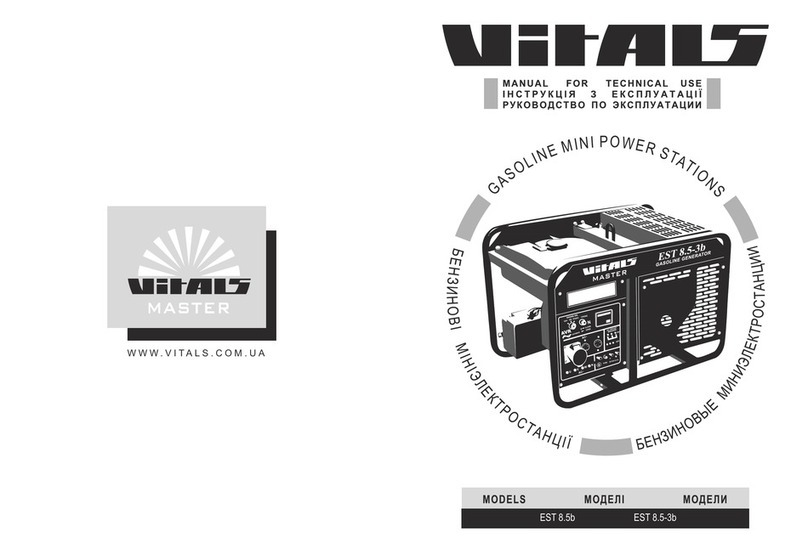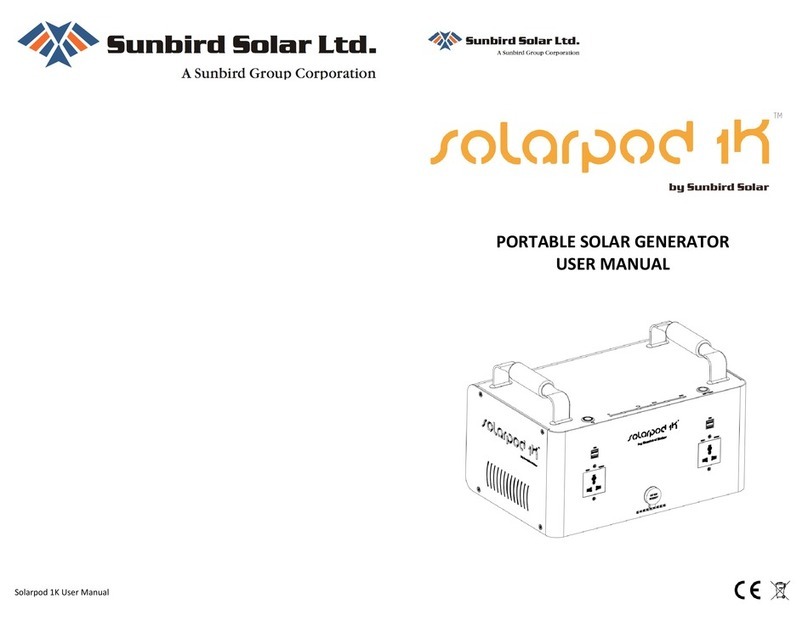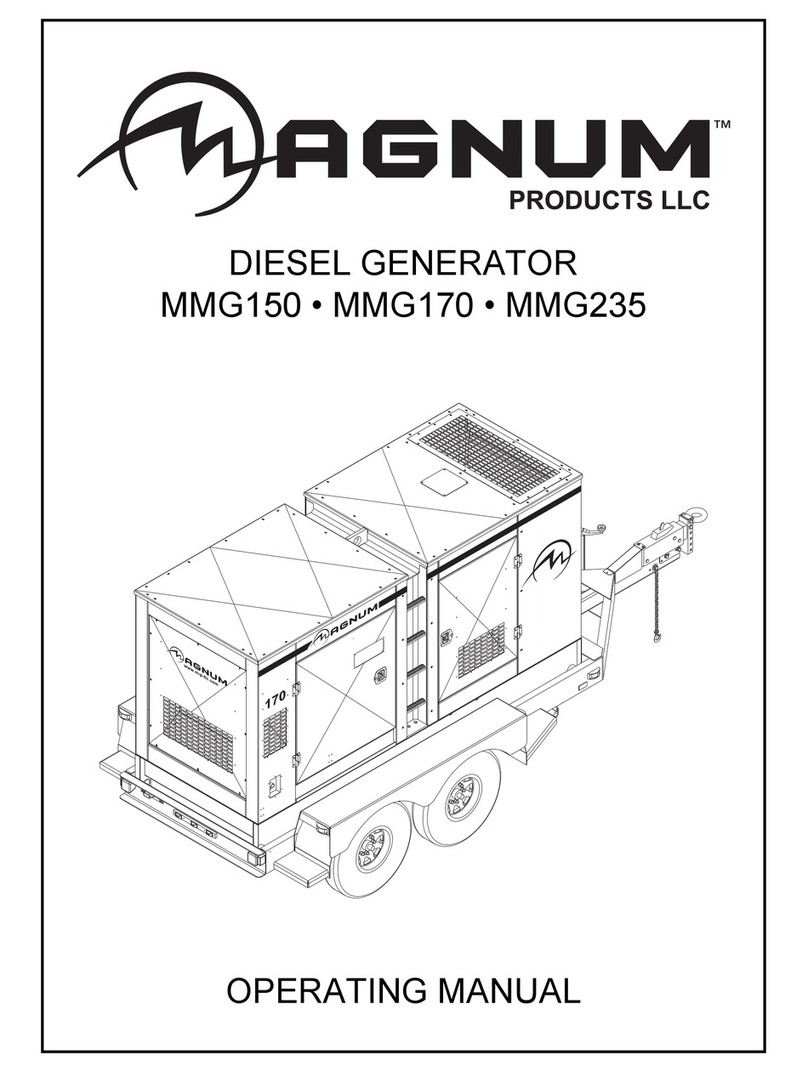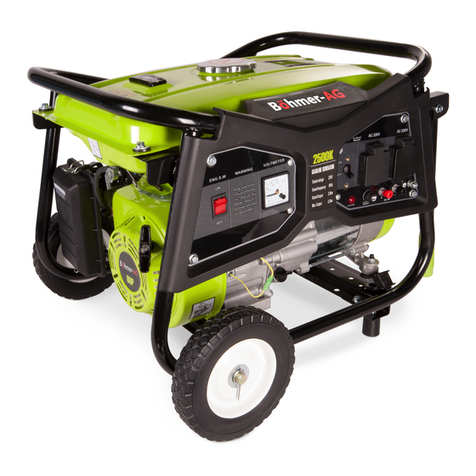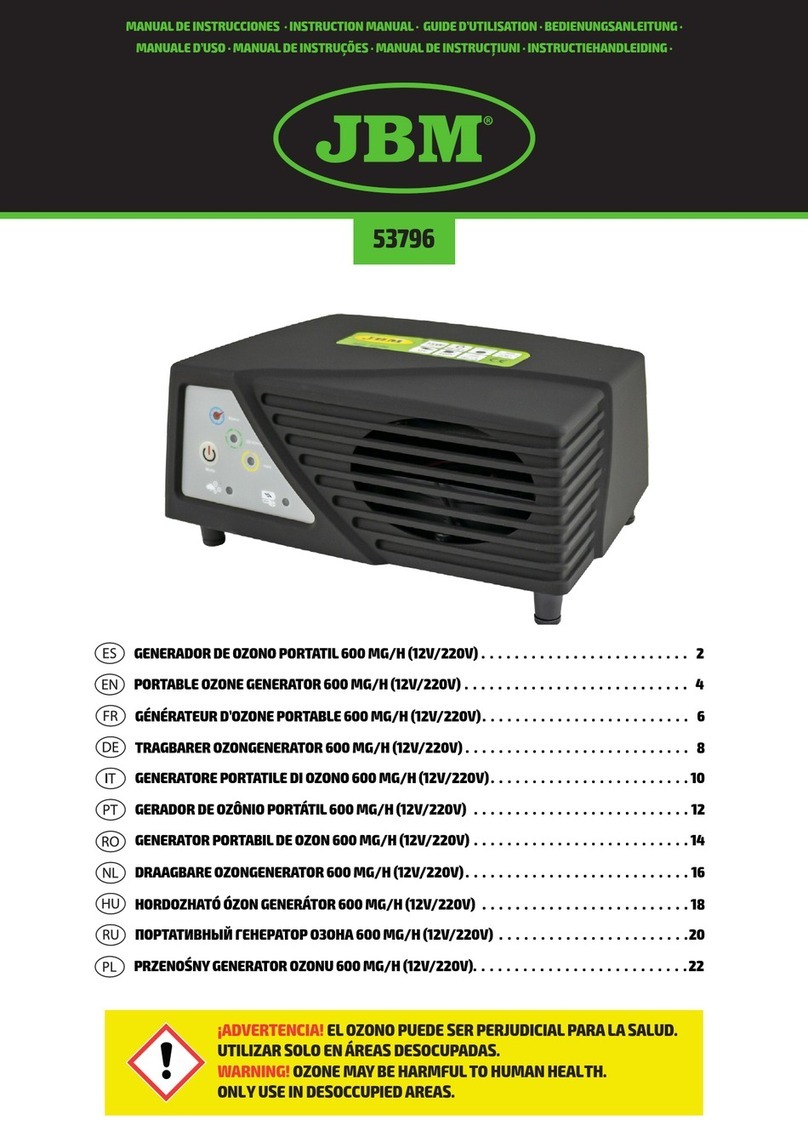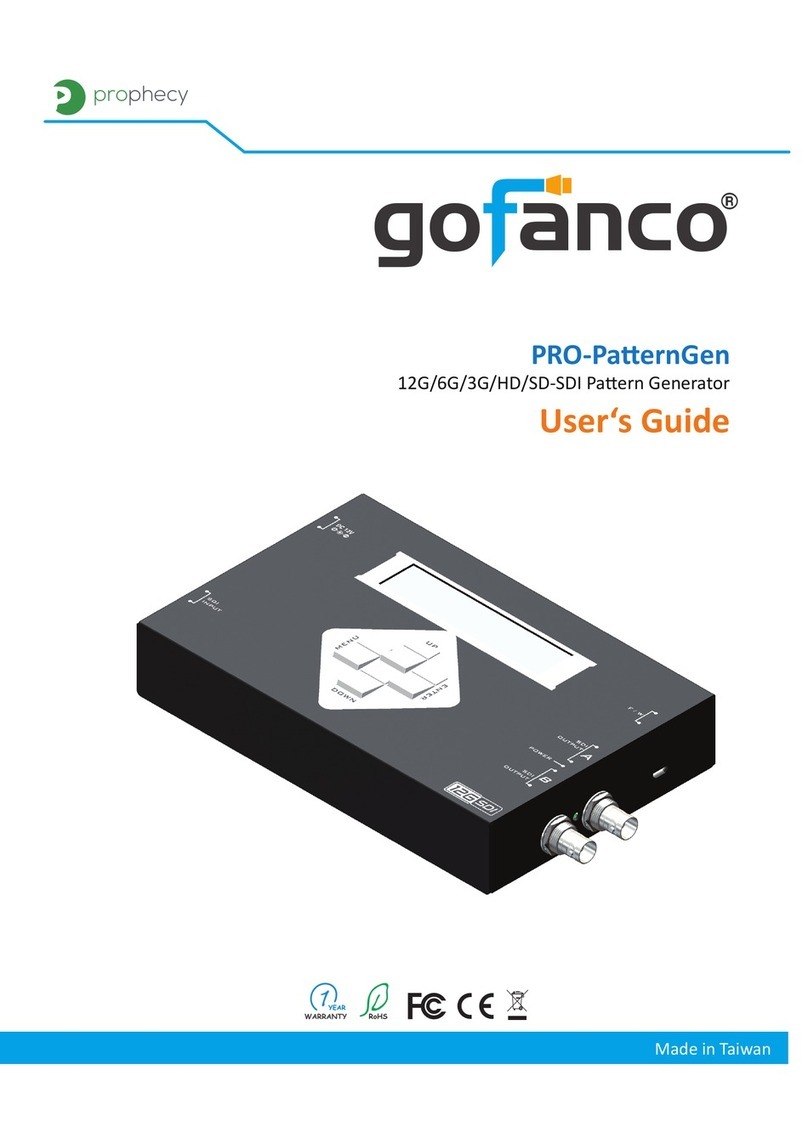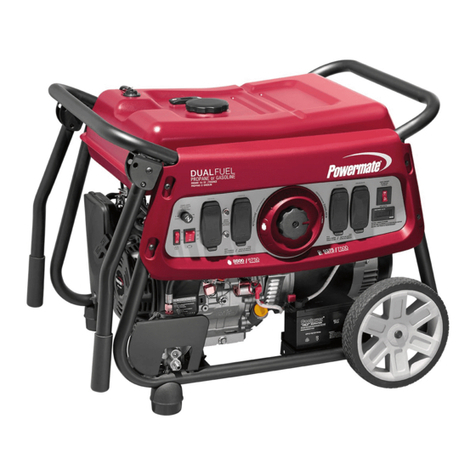Vitals ERS 4.6d User manual

W W W . V I T A L S . C O M . U A
ERS 4.6d
E
N
E
G
R
L
A
T
E
O
S
R
E
I
S
D
ІИ
ERS 4.6dt
S

СОДЕРЖАНИЕ
ЗМІСТ
1. Общее описание
2. Комплект поставки
3. Технические характеристики
4. Требования безопасности
4.1. Важная информация по безопасности
4.2. Безопасность эксплуатации
4.3 Заземление
5. Эксплуатация
5.1 Применение
5.2.
5.3. Работа электростанции
6. Техническое обслуживание
7. Транспортировка и хранение
8. Возможные неисправности и пути их устранения
9. Гарантийные обязательства
Подготовка к работе
1. Загальний опис
2. Комплект поставки
3. Технічні характеристики
4. Вимоги безпеки
4.1. Важлива інформація щодо безпеки
4.2. Безпека експлуатації
4.3 Заземлення
5. Експлуатація
5.1 Застосування
5.2.
5.3. Робота електростанції
6. Технічне обслуговування
7. Транспортування та зберігання
8. Можливі несправності та шляхи їх усунення
9. Гарантійні зобов'язання
Підготовка до роботи
1. General description
2. Delivery kit
3. Specifications
4. Safety requirements
4.1. Important information about safety
4.2. Safety of exploiation
4.3 Ground system
5. Exploiation
5.1 Application
5.2. Preparations to work
5.3. Generator's operation
6. Maintenance
7. Transporting/storage
8. Troubleshooting
9. Warranty
CONTENTS
УКРАЇНСЬКА ENGLISHРУССКИЙ
6
11
12
14
14
17
20
22
22
22
27
38
44
46
51
54
59
60
62
62
65
68
70
70
70
75
87
94
96
101
106
111
112
114
114
117
120
122
122
122
127
139
146
148
153

5
DEAR BUYER! DEAR BUYER!
Thank you for buying mini diesel generator TM “Vitals”.
Generators of TM “Vitals” are developed according to European quality
standards and with using of modern technologies.
Incorrect exploitation of diesel generators and non-observance of safety
measures can damage generator and can lead to serious injuries!
This Manual For Technical Use contains all necessary information about
safety measures that should be obeyed in the diesel generators' exploitation.
Learn carefully this instruction before the generator starts working.
Please, show this Manual For Technical Use to other users before they
start working with generator. This instruction should be kept for its further
exploitation.
We constantly work on improving of our production, make changes in its
appearance, equipment and the technology of production. We don't change
the main principles of operation without informing the consumer. All possible
changes will only improve the product.
ATTENTION!
Indicates a potentially hazardous situation that may result
in minor injury or damage to the product.
NOTE!
Marks important additional information.
WARNING!
Means potentially dangerous situations, which are to be
avoided, otherwise can appear a danger for health or life.
KEY WORDS MEANING
4

7
6
GENERAL DESCRIPTION
1
Diesel generators (generator) are fixed devices, which are equipped with
electric AC generator with diesel internal combustion engine. This engine and
generator are connected to each other directly, and are fixed on a steel frame
by damping props.
The generator is attached to the flange of the crankcase with four bolts. The
transfer of torque from the engine to the generator is provided by the conical
coupling of the generator's rotor and of the motor shaft.
Diesel generators “Vitals” ERS 4.6d and ERS 4.6dt are used as a backup
or emergency source of electric power for single-phase alternating current's
consumers.
These products are made according to the current requirements of the
technology standard and level as well as to the current safety regulations.
They have a modern design, they are economical and safe in operation, are
easy to use and to maintain.
Their operating principle is very simple because the chemical energy of a
diesel fuel, which burns in the chamber of internal combustion engine, is
converted into a mechanical work, and an electric generator, which is
connected with the motor shaft, converts the speed into an electrical current.
Diesel generator is equipped with a control panel which manages the
product, with the system of his condition control and protection from the
accidents.
Distinctive features of the model ERS 4.6dt:
џa noise absorbing cover that reduces sound pressure level when the
engine is operating;
џthe lack of a recoil starter gear.
Description of the main components of the diesel generator is presented
below.
ERS 4.6d
12345678910 11 1312
14
1516
17
18
19
20
21
22
23
24
2526
2728
29
30
31
37
36
35
34
33
32
figure 1

9
8
1. Frame.
2. Fuel tank.
3. Fuel valve.
4. Fuel level indicator.
5. Automatic DC circuit protector.
6. Automatic AC circuit protector.
7. Ground system.
8. Protective cover.
9. Recoil starter rope of electromagnet.
10.Air cleaner.
11. Fuel pump of high pressure.
12.Protective cover of recoil starter and fan.
13.Recoil starter grip.
14.Fuel control lever.
15.Engine stop lever.
16.Mount bracket of engine stop mechanism.
17.Engine oil filler plug.
18.Screw-lock of fuel control mechanism.
19.Crankcase.
20.Engine oil drain plug.
21.Oil filter.
22.Decompression valve lever.
23.Oil level sensor in the engine crankcase.
24.DC terminals.
25.Voltmeter.
26.AC electrical outlets.
27.Starter switch.
28.AC generator.
29.Light indicator “Oil alert lamp”.
30.Fuel cock.
31.Storage battery.
32.Damper props.
33.Engine oil filler plug.
34.DC rectifier.
35.Electric starter.
36.Exhaust pipe.
37.Muffler.
ERS 4.6dt
figure 2
123 4 5678910 11
12
13
14
15
16
17
18

1 1
1 0
1. Noise absorbing cover.
2. Fuel level indicator in the tank.
3. Engine fuel filler cap.
4. Node for lifting.
5. Starter switch.
6. Automatic DC protector.
7. Light indicator “Oil alert lamp”.
8. Voltmeter.
9. Automatic AC protector.
10.Automatic DC protector.
11. Ground system terminal.
12.DC terminals.
13.AC electrical outlets.
14.Hatch's handle.
15.Transport wheels.
16.Hatch of noise absorbing cover.
17.Protective cover of electric generator.
18.Transport handle.
19.High-pressure fuel pump.
20.Fuel control lever.
21.Engine stop lever.
22.Mount bracket of engine stop mechanism.
23.Engine oil filler plug.
24.Screw-lock of fuel control mechanism.
25.Crankcase.
26.Oil filter.
27.Oil level sensor in the engine crankcase.
28.Fuel cock handle.
29.Fuel filter.
30.Storage battery.
31.AC generator.
32.Engine oil filler plug.
33.DC rectifier.
34.Electric starter.
1. Diesel Generator.
2. 2 ignition keys.
3. Wheels for transportation with axises and frame bindings.
4. Manual for technical use.
NOTE!
The manufacturer reserves the right to make minor changes
in its appearance, equipment, delivery kit and the technology
of production that doesn't have an impact on the generator's
operation.
DELIVERY KIT
2

1 3
1 2
Both models are equipped with automatic voltage regulator, DC terminals,
battery, electric starter system and engine protection in case of there would be
low oil level in the crankcase.
Automatic Voltage Regulator (AVR)
In diesel generators is installed a modern automatic voltage regulator that
provides a stable output voltage in the all load range. The quality of the
generators that are equipped with a voltage regulator, allows to use the
products to provide the power to complicated electronic equipment,
communications equipment, special and residential customers (computers,
televisions, boilers, etc.).
DC output
Diesel generators equipped with 12 V DC output, which is primarily used
for charging the auto battery (12 V). Red terminal is positive (+), black terminal
is negative (-). The black cable is linked up to the case products ("Grounding").
The cables should be connected according to the polarity.
Protection system from the low oil level in the crankcase
This alarm system is developed in order to prevent the damage of the
engine in case of there would be an insufficient oil in its crankcase. If there is
the low oil level in the crankcase, protection system will stop the engine, which
can prevent its damage. In this case, the indicator light «OIL ALERT LAMP»
will glow.
MODEL
Electric current
generator
AC voltage, V
Current frequency, Hz
Nominal power, kVA
Maximal power, kVA
Power factor (cos φ)
DC power
Voltage regulator
Power, h.p.
3
Operative volume, sm
Fuel
Fuel tank volume, l
Average uptime, h
ERS 4.6d
ERS 4.6dt
50
4,6
5,0
1
12 В - 8,3 А
automatic (AVR)
Engine
Type
Vertical single-cylinder
four-stroke diesel engine
with direct fuel injection and
with air-cooling
9,0
418
diesel
14
Starter system
manual
and electrical
starter
electrical
starter
16
8,5 10,0
Oil volume in the crankcase, l
Acoustic level, dB
Oil level sensor in
the engine crankcase
1,65
Noise absorbing cover
84 69
+ +
- +
Dimensions
Dimensions
(LxHxW), mm
Net weight/gross weight, kg
735х495х605
92/95
950х565х770
161/171
NOTE!
In case of an alarm system is stopped by the engine
protection system, ignition engine will be in position «ON».
SPECIFICATIONS
3

1 5
1 4
4.1. IMPORTANT INFORMATION ABOUT SAFETY
Before operating the generator read carefully the accident prevention
requirements and warnings which are written in this manual.
Most injuries which are occurred during the operation of the product are
the result of noncompliance with the basic safety rules. Injuries and accidents
can be avoided if you follow precautionary measures and after that you can
provide a potential danger.
Under any circumstances, do not use a product for purposes that aren't
provided by this manual.
There must be an accident if untrained person operates this generator
improperly.
PLEASE READ ALL INSTRUCTIONS
In order to use the product safely, you should read the instructions very
carefully. Improper operation of a device or its operation by an untrained
person can be dangerous. Read very carefully about all components of the
mini diesel generator. Learn how to stop the generator's engine if it is
necessary. If the person doesn't follow these instructions, he can have an
electric shock, serious problems with health or even can die.
RISK OF FUEL VAPOR AND EXHAUST GASES
Diesel fuel and exhaust gases inhalation, depending on their
concentration in the atmosphere, can lead to insensibility or death.
If diesel fuel has very long and frequent contact with your skin, it can cause
skin irritation, and exhaust gases' toxicity irritates mucous membrane of
respiratory tract and eyes, because there are a large amount of sulfur dioxide,
aldehydes and smoke particles in these gases.
The consistency of the exhaust gases in the atmosphere varies greatly
and depends on the type of engine, its mode of operation and loading,
technical condition and the quality of the fuel.
When you launch generator in a confined space or a room with limited
access to air, the concentration of emissions is very dangerous for human
health and life. In order to avoid the emissions' accumulation of exhaust gases
you must provide a good ventilation of the room.
SAFETY REQUIREMENTS
4
CAUTION!
Do not use the product if you are unprepared for the
operation.
CAUTION!
Do not operate generator in a confined space where there
are not ventilations and extracts.
WARNING!
Do not attempt to change the exhaust duct of generator's
engine. Do not use homemade silencers. Try to avoid the
contact of your skin and respiratory organs with exhaust
gases.

1 7
1 6
In the case of fuel ignites, switch off the engine, blocking the fuel supply to
the engine. Extinguish the fire using carbon dioxide fire extinguisher or
covering it with the hearth fire felt, canvas, etc. If you do not have them,
extinguish the fire by sand or ground.
4.2. SAFETY OF EXPLOITATION
1. DO NOT LET CHILDREN AND PERSONS WITH DISABILITIES USE
GENERATOR.
2. BE FULLY CONCENTRATED ON WORK.
Do not digress while connecting power cables, starting and stopping the
generator, as this may cause a loss of control and cause various injuries.
3. DO NOT CONNECT POWER CABLES, DO NOT START THE ENGINE
AND DO NOT USE THE PRODUCT IN CASE OF ILLNESS, FATIGUE, IF
YOU DRANK AN ALCOHOL OR TOOK DRUGS, WHICH REDUCE THE
RATE OF REACTION AND ATTENTION.
4. CONTROL THE RIGHT OPERATION OF GENERATOR.
Do not switch on the device if it is in damage.
5. WEAR APPROPRIATE CLOTHING AND SHOES WHILE USING
GENERATOR.
Wear tight clothes and fasten all buttons, take off rings, chains, bracelets
while working with the product in order to prevent them from falling into the
moving parts of the generator. Wear shoes with non-slip soles. Use
headphones or ear plugs in order to protect your hearing. When you are
working with the power cables, wear rubber gloves.
RISK OF ELECTRIC SHOCK
In case of incorrect operation of diesel generator there is a risk of electric
shock, or a death from it.
Do not work with generator or other electrical devices in wet locations, near
the water, in the rain or snow, because there is a risk to die from electrical
shock. Always keep the generator dry.
Do not keep unprotected generator outdoors.
Humidity or ice can break the device, which can also lead to electric locking
and death due to electric shock.
Check the serviceability of all electrical parts of the generator each time
before using the device.
Before connecting the device to the consumers of electricity, pre-ground
the generator. If you do not do it, there will be a risk to die, or the device will
break down.
DANGER OF IGNITION
Muffler gets very hot while the engine is operating, and remains hot for
some time after stopping, which can lead to ignition of the materials that are
near the generator.
Try to avoid the connection of all parts of your body with muffler – there is a
danger of getting burned.
Do not cover generator during operation. Do it only when the engine stops
and generator is cool.
Do not work wit generator closer than 10 meters from the location where
there are a large number of materials that ignite very quickly.
CAUTION!
Fuel is highly flammable. Before refuelling, stop the engine
and let it get cool completely.
Do not refill the product with the fuel near an open fire or in a
place where there may be sparks.
Do not smoke near the generator.
Always check the leakage of fuel. If the fuel overflows, wipe
it off very accurately.
It is forbidden to put out the fire with water.

1 9
1 8
15. BE CAREFUL WHILE WORKING WITH STORAGE BATTERIES.
The battery gives off hydrogen gas which can ignite if it connects with the
open fire. Generator should be in a well-ventilated place. Avoid the hits of
flame, sparks on the storage battery.
16. DO NOT LAUNCH THE ENGINE POWER WITH THE CONNECTED
LOAD.
Launching the engine must be carried out without the load which is
connected to the device.
17. DO NOT OVERLOAD THE GENERATOR.
The power of expected load should not exceed the rated capacity of the
generator. Do not use power cords that have damaged insulation.
18. DO NOT ATTEMPT TO REPAIR THE ENGINE AND GENERATOR. IF
THEY BREAK DOWN, CONTACT THE SERVICE CENTER.
19. DO NOT MODIFY THE FUEL SYSTEM.
Do not improve the product by the extra fuel tanks, fuel filters, hoses,
valves, electromagnetic locks, fuel pumps, etc. Do not modify the fuel
system in order to run it on a gaseous fuel.
20. DO NOT CLEAN THE PRODUCT BY FUEL.
For cleaning power, Use only non-toxic, non-flammable parts that does not
destroy the surface of the generator and its details.
21. FUELLING THE GENERATOR MUST BE DONE ONLY IN THE WELL-
VENTILATED ROOM, WHEN THE ENGINE STOPS. BUT AVOID THE
FUEL SPILLAGE ON THE DEVICE OR ON THE GROUND.
22. DO NOT MAKE A FIRE CLOSER THAN 20 METERS FROM
GENERATOR.
6. DO NOT TOUCH THE REVOLVING PARTS OF THE DEVICE.
Try to avoid the contact of your hands, fingers and other parts of body with
revolving parts of the generator.
7. YOU MUSTN'T TOUCH ELECTRIC WIRES, CONNECTORS AND
TERMINALS WHEN THE GENERATOR IS OPERATING.
High-voltage cables can lead to electric shock or death.
8. WHEN DEVICE IS WORKING, OTHER PEOPLE AND PETS MUSTN'T BE
NEAR IT (THE MINIMAL DISTANCE IS 5 M).
9. WHILE SERVICING THE PRODUCT, USE ONLY ORIGINAL SPARE
PARTS.
10. KEEP AWAY FLAMMABLE MATERIALS FROM POWER.
Fuel, engine oil, matches, oily clothes, straw, trash and other flammable
materials mustn't be next to generator.
11. DO NOT COVER GENERATOR.
Generator is equipped with a forced air cooling system, and if the device is
covered, the engine may overheat.
12. GENERATOR MUST OPERATE ON A HORIZONTAL SURFACE.
There is no need to make special stands for the product, however, power
can not operate on an uneven surface (angle should not exceed 20
degrees), otherwise there will be vibrations. If during the operation
generator is not set fixedly, it will move and the fuel will disembogue, as
well as the device can tip over and cause a dangerous situation.
If the device is operating on an inclined surface, rubbing parts will not be
lubricated properly that can lead to jamming of the cylinder group, even if
the oil level in the crankcase is normal.
13. LOOK AFTER THE LOCATION OF THE ELECTRICITY CONSUMERS'
POWER CABLE.
If generator is on the power cord or cable touches it's vibrating parts, the
cable may be damaged. It can lead to a dangerous situation: there can be
a fire or an electrical shock.
14. DO NOT LAUNCH GENERATOR IN THE RAIN OR BY WET HANDS.
Generator's operation in the rain or snow can cause electrical shock or
spoiling the device. If it is wet, wipe it dry before you launch it. Do not pour
water to the device, do not wash it.
WARNING!
Check generator's serviceability constantly. In case of
there would be heavy banging noise, vibration, flame, sparks,
stop the engine immediately and contact a service center.

21
20
4.3. GROUND SYSTEM
Ground system prevents the possibility of electric shock. In order to ground
the device, use a ground wire and ground switch (it isn't in the package) (fig. 3).
Metal pipes in the ground water, sewage or metal frames of buildings that
have a connection to the land can be used as a ground system.
If you are unable to use these ground system, use one of the
following systems:
џmetal pipe of not less than 1500 mm in length and 50 mm in diameter;
џmetal rod not less than 1500 mm in length and not less than 15 mm in
diameter;
џgalvanized steel sheet (1500x1000 mm.)
CAUTION!
Do not use generator without ground system.
figure 3
WARNING!
This manual does not take into account all the possible
cases that may occur in the exploitation of the device. That's
why you should be in common sense to comply with the
utmost attention and care while working.
WARNING!
The ground wire should have a section of at least 3.5 mm ²,
preferably of twisted copper wire.
Ground terminal and ground system should have a good
contact with the ground wire.
CAUTION!
To make a proper connection grounding get expert advice
from the relevant specialists or use their services.

23
2 2
5.1. APPLICATION
Diesel generators ERS 4.6d and ERS 4.6dt produce alternating current
voltage of 230 V, 50 Hz, and they are single-phased. The devices are made to
provide an alternating current and they can be used as an alternative power
source. It can be an emergency power source of buildings and houses can be
used for repairs without access to the main electricity grid, in the country, on a
picnic, in the garage, etc. These models have an output voltage of 12 V DC.
5.2. PREPARATIONS TO WORK
Before the launching of the generator, do next actions:
1.Pull the power out of the box carefully; avoid shock or mechanical impact on
the parts of the device.
2. Place it on a horizontal surface.
3. Carefully inspect the power plant for damage. Pay attention on the integrity
of the electrical part.
4. Check the hoses, fuel tank filler hole and the oil compartment, the fuel cock
as well as other possible spots where there is risk of fuel and oil leaks. If it is
necessary, repair the leak.
5. Check the oil level in the crankcase and, if it is necessary, add some oil.
6. Check fuel level in the fuel tank and add some. There should be left a small
airlock in the fuel tank for a possible expansion of the fuel vapor.
7. Check all key details. If it is necessary, lift bolts and nuts.
8. Check the integrity of the damper stands, replace them if it is necessary.
9. Check the integrity and purity of the air filter.
Engine
New or recently renovated engine must be running for 25 hours. It must
operate at low speed and at low load, since it affects the durability of the
engine.
Oil
Oil is a fundamental factor that has a direct impact on the operating of the
engine. Use engine oil for engines with the specifications on API SJ, SL. The
recommended viscosity of engine oil is SAE 10W30. Other types of viscosity
shown in the table (see fig. 4) may be used in cases when the average
temperature in the region, where the device is operated is in the proper range.
EXPLOITATION
5
WARNING!
If there are damaged damper stands, don't switch on the
generator.
This may lead to increased vibration and, as a
consequence, failure of the device.
WARNING!
Do not use the product in the absence of the air filter or
when it is dirty, because there is a risk to damage the engine.
WARNING!
The diesel engine must be running at rated frequency
speed and at rated load speed. If there are deviations in the
engine, stop it immediately, find out causes and take remedial
measures.

2 5
2 4
Oil filling:
1. Clean the area around the engine oil filler plug thoroughly and the plug itself
from contamination to prevent the ingress of dust and dirt into the
crankcase.
2. Remove this plug and wipe it dry.
3. Pour into the oil filler necessary amount of oil (use a funnel in order to avoid
the spilling of oil).
4. In order to measure the level of oil put the plug into the oil filler neck, but do
not torque it. Remove the plug- and check the oil level. If it is below the
minimum level mark on the dipstick, add oil until the level of the upper limit
(the lower edge of the filler neck) (see fig. 5).
5. Torque the plug.
6. If oil spills on the device, wipe it dry.
Oil filter
Oil filter is to remove contaminants from the engine oil by filtration (see
fig. 1 (pos. 21) – ERS 4.6d model, fig. 2 (pos. 26) – ERS 4.6dt model).
Before the first use of the product fill the crankcase with 1.65 liters of oil
(special oil for diesel engines).
40
30
20
20W/40
20W
15W/40
15W/30
5W
10W30
10W/20
10W
5W/30
5W/20
5W
-30 -20 -10 0 10 20 30 40 50
Environmental temperature, °С
figure 4
NOTE!
Generators are supplied without oil in the crankcase!
NOTE!
Do not use the generator if there is an insufficient or
excessive oil level.
Do not fill the crankcase with oil that lost its quality, as well as
oil, that is not for the engine. Do not put special additives into
the oil. Do not mix oil with fuel.
MIN
MAX
figure 5
WARNING!
Change oil regularly. The first oil change make after break in
25 hours, at the end of the first month of operation, and then -
every six months or after every 100 hours of operation.
WARNING!
Checking the status of the oil filter, cleaning it and replacing
should be in accordance with the regulations (see section 6 of
this manual, "Maintenance").
WARNING!
Using the product without oil in the crankcase is strictly
prohibited.

27
2 6
Fuel
While refuelling, use only clean, fresh diesel fuel. Filter diesel fuel before
refuelling using silk or let it stand for 24 hours. Do not allow dust, dirt, debris or
water to fall into the fuel and into the fuel tank.
Diesel fuel level in the fuel tank should be checked before starting the
engine of generator. If the engine has just stopped, wait for 4-5 minutes or
more, so that the engine cools down, and only then start the refuelling.
Refuelling should be done only in the way when an airbag remains in the fuel
tank for the possible expansion of the fuel vapor when it is heating. The
maximum fuel level should be 2-3 cm below the lower edge of the filler neck of
the fuel tank.
Fuel filter
Both models are equipped with a fuel filter that allows the selection of fuel
solids and the separation of relatively large mechanical particles and water by
settling them.
A clogged fuel filter can be the cause of difficult engine start, of losing its
power, incorrect operating. In addition, dirty fuel filter can significantly reduce
the life of the engine.
Air filter
There is an air filter with a dry filter element on the engine power, which
condition should be checked before each engine's launch. It is strongly
recommended to check the air filter and change it according to the regulations
(see section 6 of this manual, "Maintenance").
A clogged air filter can be the cause of difficult engine start, of losing its
power, incorrect operating. In addition, dirty air filter can significantly reduce
the life of the engine.
5.3. GENETATOR’S OPERATION
NOTE!
The device is sold without fuel in the fuel tank. Before each
use fill the fuel tank with diesel fuel.
NOTE!
Fuel filter of the ERS 4.6d model is installed inside the fuel
tank.
WARNING!
Refuelling should be done only when the engine doesn't
operating!
WARNING!
Oil and fuel mustn't have contact with paper filter elements.
WARNING!
It is forbidden to launch the engine of generator without the
air filter or the filter with unclosed fuel valve.
WARNING!
Before the exploitation of the device, please, make the
engine breaking-in. Details, see the section below.

2 9
2 8
3. Move lever fuel control by your hand in the direction of the arrow «RUN»
(see fig. 8).
4. Put the ignition key into the ignition and turn to position «START» (see
fig. 9). Hold the key in this position until the engine starts, then, release the
key. To prevent failure of the generator, do not hold the key to the position
«START» more than 15 seconds.
ELECTRIC STARTER'S LAUNCH
1. Put battery on the regular place. Observing polarity, connect the power
cables to the battery (black "Grounding" to "-", red «Starter» to "+").
2. Open the fuel cock. Turn the fuel cock lever «FUEL COCK» in position
«ON» («OPEN») (see fig. 6 - ERS 4.6 d model, fig. 7 - ERS 4.6dt model).
CAUTION!
Be sure that the AC circuit breaker is disconnected! It is
forbidden to launch the generator's engine if the electricity
consumers are connected to the device. The connected load
makes it difficult to launch the engine and may damage it.
NOTE!
ERS 4.6d engine model can be launched by a manual and
electric starter. ERS 4.6dt engine model is not equipped with a
manual starter and is launched only by an electric starter.
figure 6
figure 7
1
2
1. Fuel control lever.
2. Engine stop lever.
figure 8
figure 9
WARNING!
If the engine does not start within 15 seconds, release the
ignition key, wait for 15-20 seconds (this allows the battery to
recover) and try again.

3 1
3 0
5. Warm up the engine, letting it run for 5 minutes at idle speed until you find a
good pace.
LAUNCHING THE ENGINE BY THE RECOIL STARTER (ONLY ERS
4.6D MODEL)
1
1. Open the fuel cock and turn the fuel cock lever («FUEL COCK») to position
«ON» (see fig. 6).
2. Move lever fuel control in the direction of the «RUN» arrow (see fig. 8).
3. Take the starter handle and slowly pull it up until you feel the resistance.
4. Pull down the decompression valve lever («DECOMPRESSION LEVER»)
(see fig. 10).
5. Firmly holding (in two hands) starter handle, pull the entire length of the
cable sharply and vigorously. You should do it carefully in order not to pull
the cable out of the holder. Do this as soon as the engine starts.
Decompression valve lever will return to its original position automatically
when you pull the starter handle.
6. Warm up the engine, letting it operates for 3-5 minutes at the idle speed until
there will not be good paces.
If the engine does not start after three attempts:
џCheck the fuel for the presence in it of mechanical solids and water;
џCheck the condition and cleanliness of the air filter element;
џCheck the oil level in the crankcase;
џRepeat launching.
NOTE!
If there is not enough oil in the crankcase, the engine will not
start. Check the oil level, and, if it is necessary, add oil.
figure 10
1
1. Decompression valve lever.
WARNING!
Do not pull the cable of a manual starter when the engine is
running, since the engine may be damaged.
Do not allow the starter rope to return back sharply to its
original position, return it slowly by hand.
WARNING!
You should not warm up the engine at high speeds because
it reduces the life of the engine.
WARNING!
Check the tightness of the external connections of the
motor housing, fuel system and exhaust emissions' control.
NOTE!
If these measures to launch the engine fail, refer to
section 8 of this manual, "Troubleshooting” and find how to
overcome your problems with the engine, or call a service
center.

3 3
32
ENGINE LAUNCHING IN THE COLD SEASON
The ambient temperature, which is below 0 °C, causes:
џwhen the viscosity of the oil in the crankcase increases, the resistance of
cranking and the piston, and the rotation of gear transmission increase too;
џwhen the viscosity of diesel fuel increases, the fuel pressure, which is
supplied to the injector high-pressure fuel pump, decreases;
џwhen the energy of storage battery decreases - the torque, which is
developed by an electric starter when the diesel engine starts, reduces.
For reliable diesel engine starting at temperatures below 0 °C:
џuse only high-quality winter fuel;
џdrain the oil from the crankcase, heat it up and pour the warm oil into the
nozzle holes for oil;
џIn order to heat the oil in the crankcase, use pre-heaters, which are based
on the hot water and steam using;
3
џunscrew the plug of the oil engine head hole, pour into the hole 2 sm of
engine oil, tighten the plug and start the engine immediately. During engine
operation the plug must be torqued tightly hold because the engine can
start to suck the dust, that will lead to its failure;
џhold the ignition key on the «START» position after the first outbreaks of
fuel in the cylinder, scroll starting engine for several seconds until you see
flashes (at this time the motor can not be operating on idles, but it can be
operating on lower turnovers);
џpay attention on the exhaust gases. If there are blue pillars of smoke from
the exhaust pipe of the muffler, it is "cold" fuel combustion.
CAUTION!
In order to ensure easy starting engine, do not use an open
flame while heating oil in the crankcase, do not add volatile
liquids to the air intake, such as kerosene, petrol, white spirit,
as this can cause an explosion of fire engine.
ENGINE STOPPING
1. Turn off the electricity consumers and let the engine run at idle speed for 1-2
minutes.
2. Turn off the circuit breaker at the AC power panel.
3. Turn the ignition key to «STOP» (see fig. 9). After that an electromagnet
starts operating, which by cable will activate the motor stop lever.
4. In case of emergency, when the engine stop lever is not activated by the
described method in the preceding paragraph, press the plug on the engine
stop lever down to the «STOP» arrow (see fig. 8).
5. After stopping the engine, close the fuel valve - turn the fuel cock lever
(«FUEL COCK») to position «OFF» («CLOSE») (see pic. 6 and fig. 7).
6. Pull the recoil starter handle slowly (when the engine is completely stop-
ped!) until you feel the resistance (these are the intake and exhaust valves
of the engine), and let the handle go. This will prevent the engine from
corrosion during its storage (only ERS 4.6d model).
ENGINE'S RUNNING
One of the most important moments in the device's exploitation is new
engine's running. If the running of the engine is correct, its service life will
increase considerably.
WARNING!
A sudden engine stoppage could lead to an undesirable
increase in temperature and it shortens engine's life.
WARNING!
When the engine is stopping, decrease its turnovers slowly.
It is forbidden to stop the engine by the decompression valve
lever (only ERS 4.6d model), as this will inevitably lead to
failure of the engine.

3 5
3 4
Engine's running procedure:
1. Start the engine and let it run at idle for 10 minutes. Stop the engine and
allow it to become completely cool. This procedure must be repeated 5
times.
2. Start the engine and let it run at idle for 60 minutes. Stop the engine and
allow it to become completely cool.
3. The first 25 hours of operation of the device, the load should not exceed
50% of the nominal figure. The work should be carried out by stages. Each
stage should not exceed 3 hours.
4. After 25 hours of the device's operation, replace the oil, after washing the
engine. Fill the generator with 1.65 liters of oil and run the engine for 10
minutes. Drain flushing oil, wash the oil filter and fill with new oil. Use for
cleaning the oil according to the ambient temperature.
BEFORE CONNECTING THE ELECTRIC CONSUMER
џEnsure that electrical appliances which are connected to the generator,
are intact and free of defects. Because there can be an electric shock or
fire;
џMake sure that the total power consumption of all connected electrical
appliances do not exceed the rated output power;
џThe operation time of the generator between nominal and maximum power
should not exceed 5 minutes. Otherwise, this could lead to product failure;
џIf you are using an extension cord, make sure that it is completely
unwound, and cable cross-section corresponds to the connected load. If
an extension cord or a cable has insufficient wire size, it can lead to voltage
drops, cable overheating and instability operation of connected
consumers;
џDo not overload electrical outlets of the generator. Each outlet has that
power, for which it is made. Try to distribute the load evenly between the
power outlets. The maximum current carrying capacity of a single electrical
outlet power must not exceed 16 A.
CALCULATION OF LOAD AND CONNECTION
Connect only single-phased power consumers with an operating voltage
of 230V ± 20% and frequency of 50 Hz to generator's ERS 4.6d and ERS 4.6dt
models.
The rules for calculating the load
1. Starting power of the connected to the generator unit with the highest inrush
current does not exceed the maximum capacity of the generator's product.
2. The total power consumption of all devices (with reactive and active loads)
must not exceed the rated capacity of the generator.
3. To calculate the correct load, you should consider the power factor of the
device.
4. There should be a 20% of power margin for proper and safe operation of the
diesel generator.
5. The power of connected consumers must not exceed the maximum power
socket of generator.
WARNING!
Do not connect the product with the electrical power
consumers, which power exceeds the maximum capacity of
the device.
NOTE!
Many appliances have the so-called inrush current, which
briefly increases the power consumption of electrical
appliances in several times. On this basis, to supply the power
consumers they must get the necessary power to run. Starting
capacity of such devices shall not exceed the maximum
capacity of this generator. The user, who has the highest
starting power, should be connected first to the device.

3 7
3 6
Consumers of electricity are divided into active and reactive.
Active consumers have the most common load. Consumers have such a
heavy workload entire electrical energy which is converted into heat. For
example: incandescent lamps, irons, heaters, electric stoves, hair dryers, etc.
To calculate the total power of consumers it is enough to combine the power of
these devices (the power is indicated on the device itself).
Consumers have reactive loads, which are provided with an electric motor,
where the energy is consumed in order to create an electromagnetic field.
These customers include pumps, machine tools, power tools, refrigerators,
washing machines, etc. A measure of reactivity is the power factor (cos φ). To
calculate the actual power consumption of reactive generators, the power
must be divided on cos φ. For example: if for an electric drill of 600 W of power
cos φ is 0.8, so its work will require 600 W / 0.8 = 750 W of power. This must be
considered when calculating the total power consumption of consumers
which are connected to the generator. The cos φ value of such appliances is
specified on the label or in the manual of each device.
It should also considered that every generator has its own cos φ. For
example, if the coefficient is 0.8, so for this drill's operation it is required
750 W / 0.8 = 938 watts.
In order to avoid the generator's overloading there should be calculated the
total power of the connected devices, which his not more than 80% of the
nominal power of the device.
You should connect consumers to the generator only when the engine is
running, but the AC circuit breaker must be disabled at this time. Connect the
customer, switch on the AC fuse, and only then start the consumers. The
turning on of several electrical appliances should be done consistently and be
started with a device that consumes the most power.
USING THE DC OUTPUT
ERS 4.6d and ERS 4.6dt generators are with a DC output. Maximum DC
power is 12 V-8,3 A. This output is used to charge the batteries, as well as for
connecting the DC loads.
How to connect the consumer to the DC output
1. Disconnect the AC fuse.
2. Start the engine.
3. Connect two-conductor power cables of the appropriative length and cross-
section of at least 6 mm of each core to the DC terminals. Securely tighten
the clamping nut of the terminals.
4. Observing polarity, connect the power cables to the battery or DC loads.
NOTE!
Generator's ERS 4.6d and ERS 4.6dt models have the
power factor (cos φ), which is equal to 1.
WARNING!
The engine will automatically increase the pace with
increasing load of electric generator.
WARNING!
If there is a short circuit between the terminals the
automatic DC circuit breaker turns off.
WARNING!
While charging, the battery generates toxic flammable
gases. The charger operates only outdoors or in a well-
ventilated area. Avoid the generation of flame and sparks
while charging the battery.

3 9
3 8
MAINTENANCE
6
ERS 4.6d and ERS 4.6dt generators are stocked with modern, reliable and
economical diesel engines, which are based on long-term, trouble-free and
continuous operation. However, it is important to hold the simple maintenance
works regularly. This works are described in this section of the manual.
The reliability and durability of the products are largely dependent on the
accuracy and timeliness of the service.
Before every operation:
џMake the visual inspection of generator in order to detect the faults and
damage, sagging fuel and oil and eliminate the causes of malfunctions;
џCheck the engine mounts on the frame of the generator and, if it is
necessary, tighten the fasteners. Check the condition of the damper
supports;
џCheck the condition of power cables, if there is any damage – replace
them;
џCheck the oil level in the crankcase of the engine, top up it if it is necessary;
џCheck the fuel level in the fuel tank, top up it if it is necessary;
џCheck the condition of the muffler;
џCheck the engine cooling system;
џCheck the condition of the battery;
џCheck the cleanliness of the air filter.
WARNING!
Before starting the maintenance works of generator, stop
the engine and disconnect all power cables.
NOTE!
Maintenance of the devices are recommended for the
experienced professional. In case of difficulties with
maintenance, please, contact a service center.
* - it is recommended more frequent maintenance when used in dusty areas.
** - this type of work should be carried out by a qualified service technician.
MAINTENANCE/
RECOMMENDED TERMS
Diesel generator
Connections and
fastenings
Engine oil
Oil filter
Cooling system
Nozzle
cleaning
checking
change
checking
cleaning
checking
Air filter
Fuel filter
washing
checking
drainage
Muffler
Fuel pipe
tightening
washing
change
checking
checking
*
*
Periodic inspections and maintenance operations of the generator
Every
time
First 25
work
hours or
1 month
Every 50
work
hours or
3 months
Every
100 work
hours
or
6 months
Every
300 work
hours or
1 year
change
washing
change
washing
Fuel tank
High pressure
fuel pump checking
Intake and exhaust
valves' gaps
cleaning and
adjustment
*
*
*
*
*
*
**
**
**
*
This manual suits for next models
1
Table of contents
Languages:
Other Vitals Portable Generator manuals
Popular Portable Generator manuals by other brands
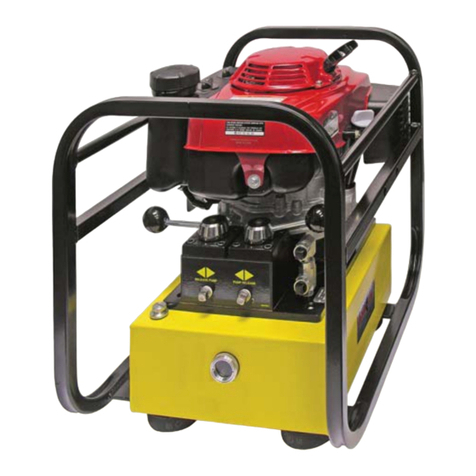
Amkus
Amkus GH2S2XLNT User's information manual

GoMax Electronics
GoMax Electronics PG-303K user manual

Scheppach
Scheppach SG3200 Translation of original instruction manual
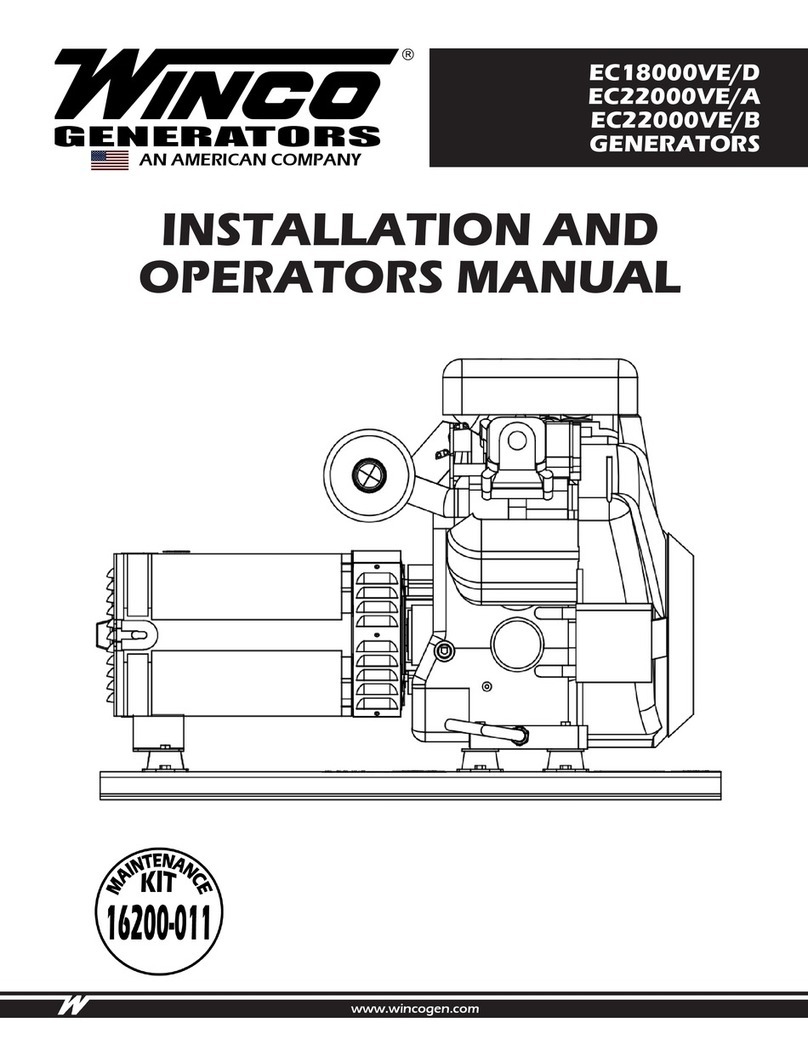
Winco
Winco EC18000VE/D Installation and operator's manual
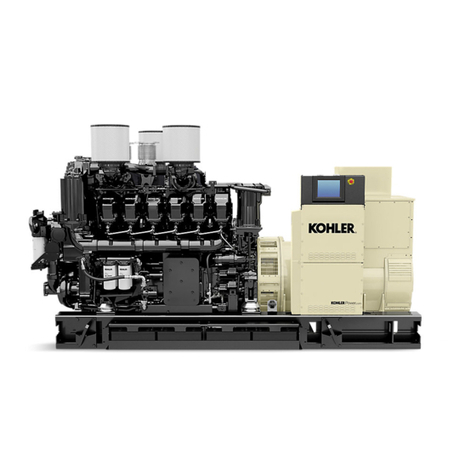
Kohler
Kohler Power Systems KD Series installation instructions

Clarke
Clarke IG950 Operation & maintenance instructions
